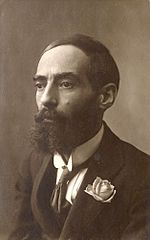Camilo Pessanha facts for kids
Quick facts for kids
Camilo Pessanha
|
|
|---|---|

Camilo Pessanha
|
|
| Born | Camilo de Almeida Pessanha 7 September 1867 Coimbra, Portugal |
| Died | 1 March 1926 (aged 58) Macau |
| Occupation | Public defender, Judge, Teacher, Poet, Writer |
| Genre | poems, essays and translations |
| Literary movement | Symbolist poetry |
| Notable works | Clepsidra |
Camilo de Almeida Pessanha (born September 7, 1867 – died March 1, 1926) was a famous Portuguese poet. He is known for his unique style of poetry called Symbolism.
Contents
Camilo Pessanha's Life Story
Growing Up in Portugal
Camilo de Almeida Pessanha was born in Coimbra, Portugal. His father, Francisco António de Almeida Pessanha, was a law student. His mother was Maria do Espírito Santo Duarte Nunes Pereira. Camilo was born on September 7, 1867. He had four younger brothers and sisters.
In 1870, his family moved to the Azores. His father became a public defender there. By 1878, the family lived in Lamego. Camilo finished his basic schooling in Lamego.
In 1884, he completed his secondary studies. He then started studying law at the University of Coimbra, just like his father. A year later, he wrote his first poem. Over the next few years, he wrote more poems. Some of these were published in local newspapers.
From 1888 to 1889, he paused his studies. This was because of his health. In October 1889, he went back to his studies. He became close friends with António Osório de Castro. António was a fellow student and ran a newspaper. Camilo published some of his poems there. Camilo also became friends with António's sister, Ana de Castro Osório. She later became a writer and a pioneer for women's rights in Portugal.
In 1890, Camilo graduated from law school. He began working as an attorney. Around this time, he discovered the works of French poet Paul Verlaine. Verlaine's poems greatly influenced Camilo's own writing.
Moving to Macau
In August 1893, Camilo Pessanha became interested in the mysteries of the East. He applied for a job as a philosophy teacher. This job was at a new school in Macau. Macau was a Portuguese colony far away in China. He was chosen for the job on December 18.
On February 19, 1894, he sailed to Macau. He arrived there on April 10. In Macau, he started a family. He had a son named João Manuel in 1896.
Camilo Pessanha returned to Portugal several times for short visits. This was often due to his health. During one of these visits, he met Fernando Pessoa. Pessoa was a big fan of Camilo's poetry. Camilo's work influenced Pessoa's writing between 1909 and 1911.
Even though some people thought he was a bit unusual, Camilo became very important in Macau. He was a respected teacher of many subjects. These included Philosophy, History, Geography, and Law. He also worked as an attorney and a judge. He advised the governors of the city. In 1900, he became a public defender. Later, he became a judge.
To pass the time, he wrote poetry. He also learned about the local culture. He collected Chinese art. He became a respected expert on China in the colony. Camilo Pessanha died on March 1, 1926, from a lung illness.
His Amazing Poems
Camilo Pessanha had a special talent. He could rewrite his poems from memory. He also often gave his poems to friends. Because of this, many of his poems were lost or accidentally destroyed. To prevent more loss, Ana de Castro Osório asked him to put all his poems into one book.
With Camilo's permission, João de Castro Osório published a book called Clepsidra in 1920. In the years that followed, other poems by Camilo appeared in Portuguese newspapers. These poems were not in Clepsidra. New editions of Clepsidra came out in 1945 and 1956. Later, more poems and different versions of his work were found. These included his translations of Chinese poems.
Camilo Pessanha was first influenced by poets like Cesário Verde and Paul Verlaine. He became the purest of Portuguese Symbolists. Symbolism in poetry focuses on using symbols and images to suggest ideas and feelings, rather than directly stating them. His poems had a great impact on a group of writers called the Geração de Orpheu. This group included famous poets like Mário de Sá-Carneiro and Fernando Pessoa.
See also
 In Spanish: Camilo Pessanha para niños
In Spanish: Camilo Pessanha para niños

